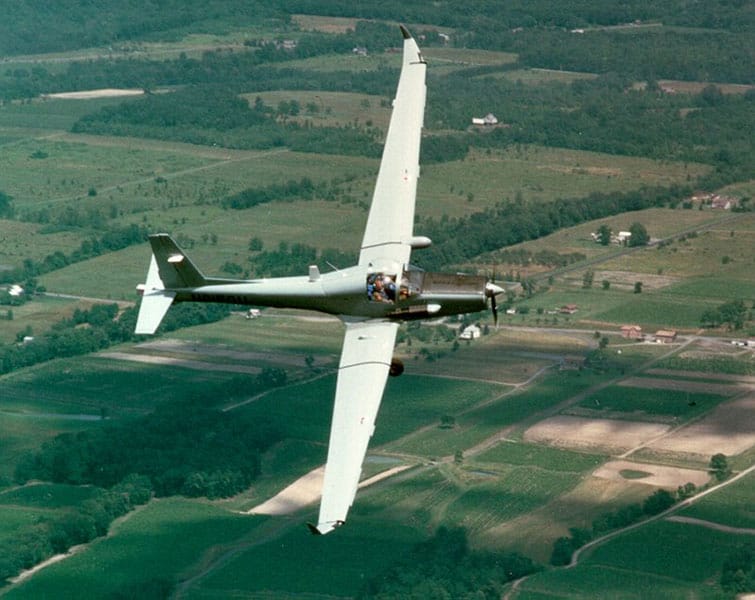
The RG-8A was developed by the U.S. Air Force under a “black” procurement program in 1986. It was a derivative of the Schweitzer motor-glider and was engineered and used to perform covert surveillance missions. Mission versatility was designed into the aircraft. The Coast Guard acquired three of these aircraft in 1986. They were used for drug interdiction, locating illegal immigrants, documenting fisheries violations and detecting the pollution of oceans and rivers. Careful matching of the aerodynamic design with the propeller, engine and mufflers enabled the RG-8A to operate with engine RPMs between 1,000 to 1,300 during the “quiet” mission mode. It was equipped with a six cylinder reciprocating Lycoming T10-540 engine rated at 250 horsepower but required only about 65 horsepower to maintain altitude in the “quiet” mode. The engine was highly muffled with exhaust vents over the low wing. The low RPM propeller speed vastly reduced the noise generated by the prop tips. The aircraft was painted with low contrast IR paint and was fully night vision goggle compatible. This combination permitted safe operation in the night sky, with virtually no chance of detection, at altitudes as low as 600 feet above the water.
The RG-8A was equipped with an AAQ-15 Forward Looking Infra-Red image system (FLIR). The FLIR data was recorded on a VHS tape along with voice narrative by the pilot and the sensor operator indicating time, location and a description of activities. Navigation avionics consisted of a VOR and DME as well as RNAV. Offshore, Omega was utilized modified by GPS, providing position accuracy within 100 feet. A complete communications suite of VHM-AM, secure UHF and HF, a protected VHF-FM, and a GEOSTAR satellite communication system was installed. A Sperry WX-11 Stormscope was added for weather avoidance. Crew safety was addressed by obtaining a special low profile parachute with an integral seat pan raft utilizing a new boat hull design.
The aircraft was flown by a single pilot, assisted by a Surveillance System Operator (SSO) who was trained to operate both navigation and surveillance equipment. A typical night mission profile would have been a coordinated patrol with a Coast Guard cutter or other search asset, flying a search area of approximately 500 track miles. Upon location of the target, using night vision goggles, the RG-8A transitioned to covert “quite” mode operation using a very low power setting, then descended to an altitude which allowed the SSO to classify and record the target and its activities on the FLIR.
A twin turbine design, designated as RU-38B evolved directly from the RG-8A. In addition to the twin turbines the RU-38B had a larger cockpit, higher useful load capabilities, improved sensors, and noise signature reduction. In September 1999 two of these aircraft were delivered to Coast Guard Air Station Miami replacing the RG-8A aircraft. They operated over the Gulf of Mexico and the Caribbean in support of drug interdiction operations. The program was halted in mid 2000 due to problems with the aircraft meeting mission requirements.
In 2008 budget provided funds to acquire two improved RU38 surveillance aircraft as a surveillance sensor platform and that is be operated jointly by the Coast Guard with US Customs as part of the homeland security mission. Its primary mission applications include border integrity protection, counter drug activities, intelligence collection against regional instabilities, fisheries patrol, environmental monitoring, and search and rescue. For many missions, the RU-38B will be equipped with a Sea Search Radar, Moving Target Indicator (MTI) Radar, or Synthetic Aperture Radar (SAR); a Forward Looking Infrared (FLIR) System; a Low Light Level Television (LLTV), or High Resolution Zoom Television; and electro-optical, digital or conventional imaging systems.. Precise GPS position data is integrated into the payload operator’s display and the EO imagery recorded on the RU-38B’s dual recording system. The planned delivery of the two RU-38Bs has been delayed to 2011.
Specifications
| Never Exceed Speed (KIAS) | 165 |
| Service Ceiling | 24,000 FT |
| Mission Speed (KIAS) | 85 |
| Take Off Distance | 1,473 FT |
| Landing Ground Roll Distance | 1,230 FT |
| Endurance | Up to 7 Hours |
| Endurance (Quiet Mode) | Up to 12 hours |
| Wing Span | 71.2 FT |
| Wing Area | 201.1 SQ FT |
| Length | 28.83 FT |
| Gross Weight | 4,300 lbs |
| Empty Weight | 2,550 lbs |
| Payload | 710 lbs |
| Fuel | 600 lbs |
| Power Plant TIO-540-AB1AD Six Cylinder Air Cooled Turbo Charged | |
| Rated Horsepower | 250@2575 RPM |
| Constant Speed Propeller | 3 Blades |
| Useable Fuel | 99 Gallons |
| Crew | 2 |
